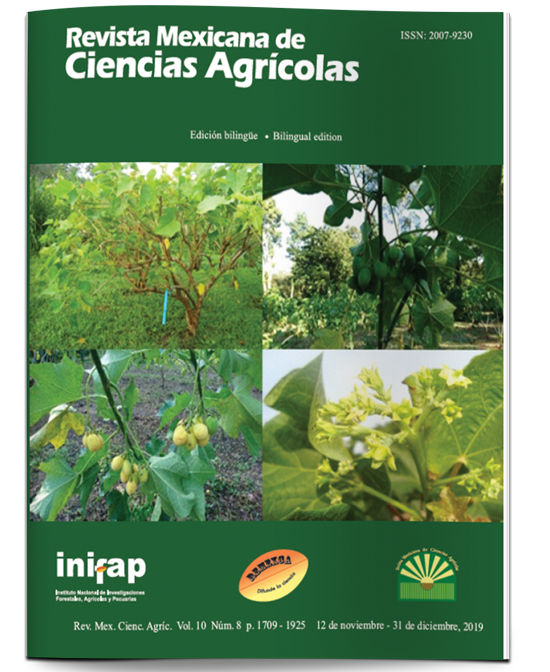Stability and adaptation of the yield and quality of tortillas in Tuxpeño corn, High-Valleys
DOI:
https://doi.org/10.29312/remexca.v10i8.1851Keywords:
Zea mays L., GGE biplot, nixtamal quality, regression sites, visual mass selectionAbstract
The V-520C variety of corn (Zea mays L.) belongs to the Tuxpeño breed, is native to Veracruz (500 meters above sea level) and was adapted to the High Valleys of Mexico (>2 200 masl) with recurrent visual mass selection (SMV) for 19 cycles The objective was to evaluate the stability and adaptation of the original V-520C (C0) and the adapted materials cycle 14 (C14) and cycle 19 (C19) for grain yield and tortilla quality through regression sites (SREG). Between 2013 and 2014, three C0, C14 and C19 genotypes were evaluated in a randomized complete block design with three replications. The evaluations were carried out in the State of Mexico and Veracruz with three experiments per entity. The analysis of variance detected significance (p≤ 0.01) between environments, genotypes and the genotype-environment interaction and in the first two Main Components for the six variables. SREG indicates that C19 had better adaptation and stability for grain yield (3.54 t ha-1), tortilla moisture at 24 h (42.72%), cold tortilla yield (1.44 kg kg-1 corn) and a reduced force for break the tortilla (193 gf). The SMV produced favorable changes to C19, which presented the best stability and adaptation in the High Valleys of Mexico. Being the Montecillo 2014-S-S environment, the one that discriminated between genotypes and the best mega-environment in the variables studied. All genotypes and environments, with the exception of Tepetates 2014-A-W and Coatlinchan 2014-S-S, met the parameters required by the NMX-034/1 standard for corn destined for the nixtamalization process.
Downloads
Published
How to Cite
Issue
Section
License
The authors who publish in Revista Mexicana de Ciencias Agrícolas accept the following conditions:
In accordance with copyright laws, Revista Mexicana de Ciencias Agrícolas recognizes and respects the authors’ moral right and ownership of property rights which will be transferred to the journal for dissemination in open access. Invariably, all the authors have to sign a letter of transfer of property rights and of originality of the article to Instituto Nacional de Investigaciones Forestales, Agrícolas y Pecuarias (INIFAP) [National Institute of Forestry, Agricultural and Livestock Research]. The author(s) must pay a fee for the reception of articles before proceeding to editorial review.
All the texts published by Revista Mexicana de Ciencias Agrícolas —with no exception— are distributed under a Creative Commons License Attribution-NonCommercial 4.0 International (CC BY-NC 4.0), which allows third parties to use the publication as long as the work’s authorship and its first publication in this journal are mentioned.
The author(s) can enter into independent and additional contractual agreements for the nonexclusive distribution of the version of the article published in Revista Mexicana de Ciencias Agrícolas (for example include it into an institutional repository or publish it in a book) as long as it is clearly and explicitly indicated that the work was published for the first time in Revista Mexicana de Ciencias Agrícolas.
For all the above, the authors shall send the Letter-transfer of Property Rights for the first publication duly filled in and signed by the author(s). This form must be sent as a PDF file to: revista_atm@yahoo.com.mx; cienciasagricola@inifap.gob.mx; remexca2017@gmail.
This work is licensed under a Creative Commons Attribution-Noncommercial 4.0 International license.



